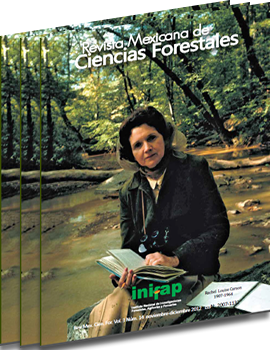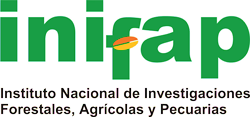MICROPROPAGATION OF Epithelantha micromeris (Engelm.) F. A. C. Weber ex Britt. & Rose, ORNAMENTAL CACTUS AND PHYTOGENETIC RESOURCE OF THE CHIHUAHUAN DESERT
DOI:
https://doi.org/10.29298/rmcf.v3i14.476Keywords:
kinetine, Epithelantha micromeris (Engelm.) F. A. C. Weber ex Britt. & Rose, phytohormones, Murashige and Skoog medium, micropropagationAbstract
A protocol which comprises four stages was made for the micropropagation of Epithelantha micromeris, a cactus in risk status, in order to obtain a good number of plants in a healthy phytosanitary condition, with uniform size to attain a successful acclimatization. The proposed propagation method is efficient compared to the traditional one. It is a new production technology which is feasible to apply in the ornamental product-system, under the scheme of laboratory-greenhouse. The seeds of this species are quiescent and can be established in vitro on a 50% MS medium in which it can get a maximum of 60% PG, which surpasses its counterpart supplemented with phytohormones (GA3); this means that the species does not need promoters for germination. The induction of shoots was obtained from epicotyl segments as explants in MS medium with different treatments. It was determined that the type and concentration of phytohormone has an influence upon the multiplication rate, generating up to 15 shoots per explant; kinetin (KIN) in interaction with AIB 10:1 in low concentration is the promoter of this effect. During the in vitro rooting it was observed that the application of 1.5 x 106 CFU ml-1 of Azospirillum brasilense has a positive effect on the rhizogenic process, generating up to 9 roots 2.3 cm long by plant. This methodology regenerates species in risk status of ecological importance for the Chihuahuan Desert and improves biological processes for the production of ornamental plants.
Downloads
Downloads
Published
How to Cite
Issue
Section
License
The authors who publish in Revista Mexicana de Ciencias Forestales accept the following conditions:
In accordance with copyright laws, Revista Mexicana de Ciencias Forestales recognizes and respects the authors’ moral right and ownership of property rights which will be transferred to the journal for dissemination in open access.
All the texts published by Revista Mexicana de Ciencias Forestales –with no exception– are distributed under a Creative Commons License Attribution-NonCommercial 4.0 International (CC BY-NC 4.0), which allows third parties to use the publication as long as the work’s authorship and its first publication in this journal are mentioned
The author(s) can enter into independent and additional contractual agreements for the nonexclusive distribution of the version of the article published in Revista Mexicana de Ciencias Forestales (for example, include it into an institutional repository or publish it in a book) as long as it is clearly and explicitly indicated that the work was published for the first time in Revista Mexicana de Ciencias Forestales.
For all the above, the authors shall send the form of Letter-transfer of Property Rights for the first publication duly filled in and signed by the author(s). This form must be sent as a PDF file to: ciencia.forestal2@inifap.gob.mx
This work is licensed under a Creative Commons Attribution-Noncommercial 4.0 International license.






